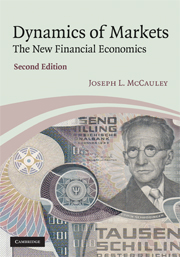Book contents
- Frontmatter
- Contents
- Preface to the second edition
- 1 Econophysics: why and what
- 2 Neo-classical economic theory
- 3 Probability and stochastic processes
- 4 Introduction to financial economics
- 5 Introduction to portfolio selection theory
- 6 Scaling, pair correlations, and conditional densities
- 7 Statistical ensembles: deducing dynamics from time series
- 8 Martingale option pricing
- 9 FX market globalization: evolution of the Dollar to worldwide reserve currency
- 10 Macroeconomics and econometrics: regression models vs empirically based modeling
- 11 Complexity
- References
- Index
5 - Introduction to portfolio selection theory
Published online by Cambridge University Press: 02 December 2010
- Frontmatter
- Contents
- Preface to the second edition
- 1 Econophysics: why and what
- 2 Neo-classical economic theory
- 3 Probability and stochastic processes
- 4 Introduction to financial economics
- 5 Introduction to portfolio selection theory
- 6 Scaling, pair correlations, and conditional densities
- 7 Statistical ensembles: deducing dynamics from time series
- 8 Martingale option pricing
- 9 FX market globalization: evolution of the Dollar to worldwide reserve currency
- 10 Macroeconomics and econometrics: regression models vs empirically based modeling
- 11 Complexity
- References
- Index
Summary
Introduction
Everyone would like to know how to pick winning stocks, but there exists no reliable mathematical theory, nor is a guaranteed qualitative method of success available to us. Given one risky asset, how much should one bet on it? According to the Gambler's Ruin, we should bet the whole amount if winning is essential for survival. If, however, one has a time horizon beyond the immediate present, then maybe the amount gambled should be less than the amount required for survival in the long run. Given two or more risky assets we can ask Harry Markowitz's question: can we choose the fractions invested in each in such a way as to minimize the risk, where risk is defined by the standard deviation of the expected return? This is the beginning of the analysis of the question of risk vs reward via diversification and assumes normal liquid markets.
This chapter is written on the assumption that the future will be statistically like the past, that the historic statistical price distributions of financial markets are adequate to predict future expectations like option prices. This assumption will fail miserably during a liquidity crunch, and also after the occurrence of any surprise that changes market psychology permanently.
Risk and return
A so-called risk-free asset has been defined historically as one with a fixed interest rate, like a CD, money market account, or treasury bill (this definition is based on the assumption that the currency in question is not systematically debased, so that at the time of writing the Euro and Yen serve the purpose far better than the Dollar).
- Type
- Chapter
- Information
- Dynamics of MarketsThe New Financial Economics, pp. 107 - 132Publisher: Cambridge University PressPrint publication year: 2009



